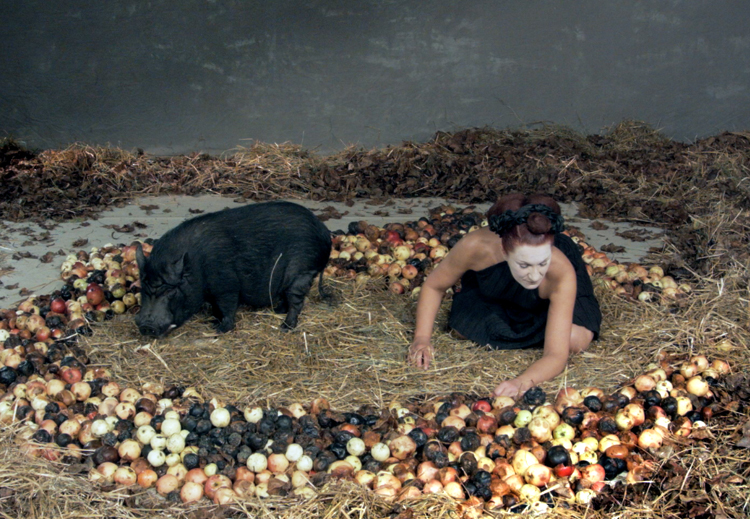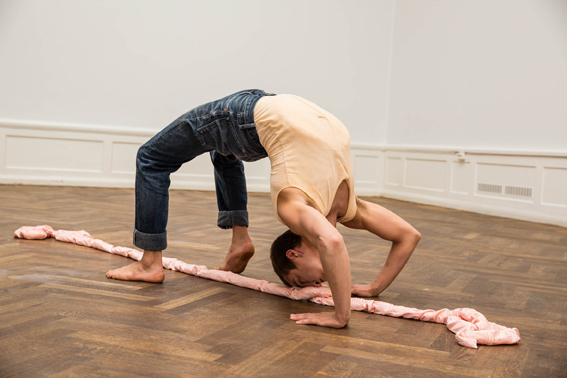Earthly Powers
EARTHLY POWERS
SU-EN, Ebba Bohlin, Pieter Aertsen
29 October – 29 November 2015
Uppsala Art Museum
Programme | Reflections by Irma Optimist and Sinéad O´Donnell
“Earthly Powers” is an exhibition and program series that in various ways deals with earthly forces that are of significance for human life; bodily functions, earth's gravity, driving forces and the movement of the senses, physical and spiritual needs and divergences. The exhibition features the video installations “Voracious – the body of gluttony” by SU-EN as well as “Transgression” and “A Tendency to Move Toward a Center of Attractive Force” by Ebba Bohlin. A third part of the exhibition features Pieter Aertsen's painting “The Butcher's Stall” from 1551, that is normally part of the Uppsala University collection on exhibit in another section of the museum. The title of the exhibition has been borrowed from the Anthony Burgess novel of the same name from 1980.
SU-EN
Voracious – the body of gluttony
In collaboration with Rickard Sporrong.
Video loop, 24 minutes. 2015
The craving world
She can never get enough
Devouring the world
She simply must taste
Consumed by the world
Who is eating whom?
The embodiment of hunger
Her body is the world
The video piece Voracious deals with notions such as gluttony, desire, thirst and desperation. The body's strong physical relationship to the world through these instincts and driving forces. The video conveys a smell of soil and putrefaction, the breathing of hunger and sounds. But also presents an act of a kind of love-making where the body yearns to taste and eat of the world to become one with it. Something dies so that something can live. An eternal cycle of life and death.
Concept: SU-EN.
Choreography, space, costume, voice: SU-EN.
Participants: SU-EN and the mini pig Laban.
Camera and post-production: Rickard Sporrong.
Sound editing and design: Rickard Sporrong.
Lighting and B camera: Magnus Göthlund.
Assistant: KAI-EN
Ebba Bohlin
Transgression
Video loop, 10 minutes. 2014
Performance enacted by Sindri Runudde in connection with the exhibition “Transgressions” at Konstnärshuset in Stockholm, 2014. Included in the piece “Transgression” is an accompanying text from the Swedish Journal on Nutritional Therapy and Functional Medicine written by Patrick Wahlberg. Both the exhibition and text deals with how parts of the body, such as the intestines, can affect the functions and well-being of the brain. Nowadays, we normally do not make a connection between the rest of the body with the brain, but that seems to be changing. Bohlin has chosen to manifest this in a piece that constitutes a transgressive expression of sorts. This performance, documented and presented as a video loop, signals man's ambivalent relationship to the physical boundaries, while at the same time referring to contemporary medical research. This nevertheless goes hand in hand with certain aspects of psychological research that tends increasingly towards neuropsychology, where our disorders and sensitivities are associated with the physical, and can thus be cured through a purely medical approach.
A Tendency to Move Toward a Center of Attractive Force
Video loop, 5 minutes. 2013/2014
Performance enacted by Sindri Runudde in connection with the exhibition “Gravity” at the Finnish Culture Institute in Stockholm, 2013/2014. The title alludes to a definition of gravity, that is, one of the laws of nature that governs the human condition on Earth. As a means of drawing attention to the fact that humans are in fact bound by the laws of physics, and that our bodies will always be matter – as a prerequisite for every thought, idea or invention – can be surprisingly controversial. We carry the wilderness in our bodies, and are forced to accept this irrational circumstance as the basis for our existence.
Alouette
Performance
Ebba Bohlin, concept, choreography in collaboration with Sindri Runudde, dancer
Time: 29 October 18:00
Place: Uppsala Art Museum, 4th floor
Debut performance of a new, site-specific performance in connection with the Vesalius jubilee, and in dialogue with Pieter Aertsen's painting “The Butcher's Stall”. Ebba Bohlin examines a bodily experience where the physical and mental processes interact. Eastern medicine is juxtaposed here with a Western view of the human body. In this performance, each part of the body is examined separately, as in the French children's song “Alouette”.
The Vesalius jubilee celebrates 500 years since the birth of Andreas Vesalius (1514-1564) and is a collaborative effort between the Hagströmer Library at the Karolinska Institute, the County Council of Uppsala, Cathedral, Uppsala Municipality and Uppsala University.
Reflections
VORACIOUS by SU-EN and Rickard Sporrong
Reflections through text on the videowork Voracious by Irma Optimist and Sinéad O´Donnell
The two artists where asked by SU-EN to reflect upon the videowork and theme and write a short text so adding yet another dimension to the work.. They arrived at Uppsala Art Museum on Friday Nov 20 at 14:30. At 15:00 they started to see the video which is 24 minutes long, and immediately they wrote the texts. At 16:00 they finished.
The texts are published on Uppsala Art Museums facebook and website and will be included in the report of the project. The visit of Sinead and Irma for this and also to participate in The Last Supper performance event on Nov 21, was financed by Swedish Arts Grants Committe.
Poem for SU-EN
She is voracious greedy for food
She invites us into her body but all we see is darkness
There is a pain when I look closer deep into her mouth
Inside there is something else
Sound overloads
I don’t know if it is drawing me in or pulling me out
It whimpers hunger
A lascivious black pig spirits her body
Woman and animal intertwine
Too late for leftovers
Buried deep in this famine of rottenness a hand appears
It struggles and disappears
Are there more bodies?
Sleeping with hunger she appears
Night chants a lullaby
Sinéad O’Donnell 20/11/15
VORACIOUS
What are the things that came to my mind first, when I looked at SU-EN´s video?
Somehow the woman was suffering and she was very thirsty. Like the earth. It is difficult to breathe, it is difficult to enjoy. Half of everything is rotten. You are hungry but you cannot eat. You feel bad. Everything is coming to a hopeless end. You try to come out of this to a more happy life. You put your hand, your foot, your head towards light, towards sun and hope. It is difficult and you have much to do to reach there, to get fresh life back.
You feel that you have to much to eat. At the same time so many people around the world are without food. You are thirsty because the fresh water is finished. You feel that many are like pigs. They eat and eat without thinking of what they are doing. You see people around you becoming bigger and bigger. You see two opposite life. There is you life, where you are with your thin body and thoughts. Then there are fat people´s life and the pig is there beside you, that we can understand. The pig seems to be quite happy in his own world.
You sing and pray that you would get a happy life as the pig. A human being must live a long life in the middle of rotten apples years after years. She must see many happy and unhappy things. She cannot be as stupid or as satisfied as a pig. The pig is treated well and you want to say that we should treat all animals in the same way. We should eat together, not eat them.
Irma Optimist
Programme
The Last Supper
Concept and score: Children of Guts (SU-EN and Hans T Sternudd)
Time: 21 November 14:00–15:00
Place: Uppsala Art Museum, Vasasalen.
Participants:
Children of Guts (SU-EN and Hans T Sternudd)
Sofia Breimo
Gustaf Broms
Per Nilsson
Eva Björkman
Sinead O´Donell (Northern Ireland)
Irma Optimist (Finland)
Astrid Azda Reinhammar
Agustin Ortiz Herrera
Johanna Rosenqvist
Kent Tankred
Mervi Junkkonen
Birgitta Granbacka
This supper ritual redefines the boundaries between the outer world and the inside of the body. In the process, a reunion takes place between man and nature to bridge a gap created by knowledge. The participants revert to a state where no names, categories or forms exist. The social norms regarding behavior are ignored and the skin becomes the canvas upon which the world is applied and slapped on. The piece is an extension of the video piece “Voracious – the body of gluttony”. With support from the Swedish Art Grants Committee.
Meat Re-Mix
Mind and body: SU-EN
Time: 26 November 18:00–18:30
Place: Uppsala Art Museum, 4th floor
SU-EN engages in a dialogue with Pieter Aertsen's (1505/1508–1575) painting “The Butcher's Stall ” in a vegetarian-feminist protest against the motif of the image. At the same time, there is also a strong sense of affinity with the meat. Of taking delight in being a body, an organism, meat. A sense of joy at the thought of one day becoming food for another living being. The piece is inspired by the book “The Sexual Politics of Meat” by Carol J Adams.
Body, Meat and Powers
Panel discussion with SU-EN, Ebba Bohlin and Anna Petronella Foultier.
Moderator Rebecka Wigh-Abrahamsson, curator at Uppsala Art Museum.
Time: 26 November 18:40–19:30
Place: Uppsala Art Museum, 4th floor
Anna Petronella Foultier (former Fredlund) defended her dissertation Recasting Objective Thought: The Venture of Expression in Merleau-Ponty’s Philosophy, Stockholm University, Stockholm, 2015. In 2010-2013, she participated in a research project on the dancer's creative process, directed by professor Cecilia Roos at The University of Dance and Circus, Stockholm, financed by the Swedish Research Council. Foultier has taught among other subjects the history of philosophy, phenomenology, ethics, theory of science and feminist philosophy, particularly at SU, Södertörn University, DOCH, Pennsylvania State University and Örebro University.

